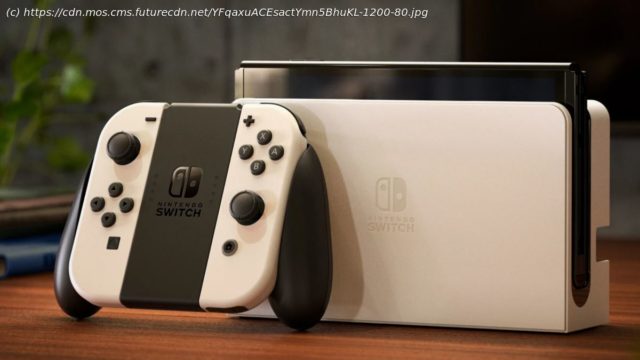The Nintendo Switch OLED is the best version of the company’s popular hybrid console to date.
Nintendo Switch OLED two-minute review
The Nintendo Switch OLED may appear to be a mild upgrade over the standard model, but the updates it provides to the handheld gaming experience are quite stark. The overhauled 7-inch display spotlights vivid colors and perfect blacks, which is a drastic improvement over the original’s dimmer LCD panel.
Outside of the display, the Nintendo Switch OLED hosts enhanced speakers to make gameplay without headphones far more enjoyable, sounding definitively less tinny than its 2017 counterpart. This alone makes the best Nintendo Switch games sound crisper than ever.
In addition, the console has twice the amount of storage as the original Switch and Nintendo Switch Lite, with a total of 64GB. That is still a far cry from the PS5 and Xbox Series X, which offer far faster storage at significantly higher capacities. However, Switch games tend to be significantly smaller, and the console has a Micro SD slot, so you can always expand if needed at an affordable rate.
So far, so good, then… but Nintendo has shamelessly overlooked one of the three core pillars of the Switch experience – TV mode – and the new console is a hard sell as a result. Despite redesigning the console’s dock, adding smoother edges, more breathing room, and even a LAN port for those who like to play online, the OLED is surprisingly bare in this crucial sector.
Another great disappointment for Switch players playing on their televisions is that you’re still capped to a 1080p output; there’ll be no 4K upscaling. So whenever you dock the Nintendo Switch OLED, all of its major selling points miraculously disappear. This boggles my mind considering that this is a console that’s supposed to cater equally to three types of play.
The lack of 4K output subsequently leads to a question that Nintendo cannot avoid when it comes to the Switch OLED: why are the internal specifications the same as the original Nintendo Switch and Nintendo Switch Lite? If you’re hoping for a Nintendo Switch Pro, you won’t find that here. Production problems have dashed dreams of this.
Everything about this feels entirely at odds with the console’s more premium feel. Countless titles and developers could have benefitted from a refresh of the Switch’s aging components, so it’s a shame Nintendo didn’t respond to the clamor from both developers and consumers with the console approaching its sixth anniversary.
So who is the Nintendo Switch OLED model for, and is it worth splashing the cash to upgrade if you already own the original Switch or handheld-only Switch Lite? Well, if you’re new to the Switch line, the answer is a definite ‘yes’ – this is the best version of Nintendo’s ingenious console to date and one that corrects many of the faults of the original model.
If you play the Switch in handheld or tabletop mode, then nothing stops you from upgrading to the OLED. The OLED has much to offer thanks to the gorgeous 7-inch OLED screen, amazing speakers, and redesigned kickstand. However, if you currently have a Switch and use it primarily in TV mode, we can confidently say that the Switch OLED would be a luxury and unnecessary upgrade.
You can watch our Nintendo Switch OLED video review below:Nintendo Switch OLED price and release date
What is it? The fourth iteration of Nintendo’s hybrid console
When did it come out? October 8, 2021
What does it cost? $349.99 / £309.99 / AU$539.95
The Nintendo Switch OLED launched on October 8, 2021, and it’s the fourth iteration of Nintendo’s home console. It costs $349.99 / £309.99 / AU$539.95, so it’s slightly more expensive than the original Nintendo Switch, which retails for $299.99 / £259.99 / AU$469.95, and it’s obviously a more considerable investment than the Nintendo Switch Lite, which costs $199.99 / £199.99 / AU$329.95.
The Nintendo Switch OLED model’s higher price tag seems reasonable, however. The upgraded console comes with a larger, 7-inch OLED display, enhanced speakers, double the internal storage and a wider kickstand, and you also get a slightly improved dock that includes a LAN port for more stable online play.
Thankfully, Nintendo has confirmed there won’t be a price hike just yet for the Nintendo Switch OLED, unlike the hikes for Oculus Quest 2 and PS5 that were blamed on global inflation. So, if you haven’t picked up an OLED model yet, there’s no need to rush.Nintendo Switch OLED design
Three modes: TV, handheld, and tabletop
Same detachable Joy-Con controllers
It comes with various accessories
If it weren’t for the larger screen and new pristine white Joy-Con controllers, you’d be hard-pressed to notice any design differences between the Switch OLED and the original Switch. However, look a little closer, and several changes can be found.
The new 7-inch OLED display is the most prominent new design feature, and it’s surprisingly impactful, despite only being 0.8 inches larger than the original Switch’s 6.2-inch screen. As a result, the Switch OLED is slightly bigger than its predecessor: it’s 0.1 inches longer, at 9.5 x 0.55 x 4 inches (W x D x H), but it still feels immediately familiar in the hands.
The Switch OLED has a bit more heft about it, though. It weighs 422 grams with the Joy-Con attached, about 22 grams more than the Nintendo Switch.






